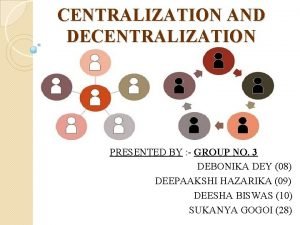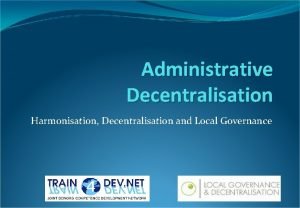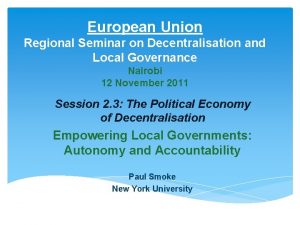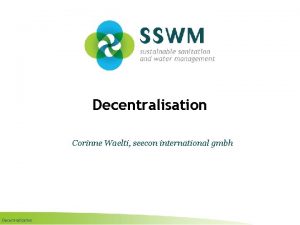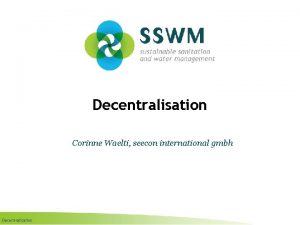European Union Regional Seminar on Decentralisation and Local














- Slides: 14

European Union Regional Seminar on Decentralisation and Local Governance Nairobi 11 November 2011 Session 1. 2: Setting the Stage/ Looking Back Regional Decentralisation Trends, Challenges and Strategies Paul Smoke New York University

Outline I. Trends and Evidence II. Diversity: Objectives, Forms, Context, Starting Points, Trajectories III. Designing Integrated Decentralisation and Local Government Reform IV. Common Realities and Challenges V. The Need for Strategic Implementation VI. Summary: What Needs Attention 2

I. Trends and Evidence Decentralisation increasingly common from the 1980 s Motivated by dissatisfaction with impact of centralised development, global pressures, aid trends, etc. Intersects with domestic political agendas Empirical literature on effects mixed and inconclusive “Macro”(mostly quantitative) focuses on analysis of broad trends (cross-/intra-national); findings typically offer limited help little with crafting specific policies “Micro” (leans qualitative but not all) can provide rich depth on specific cases; broader relevance unclear Empirical challenges: methodological, data, variable measurement, interpretation Key empirical lesson: attaining benefits depends on context and how designed/implemented 3

Decentralisation in Anglophone and Lusophone Africa Systematic comparative work limited and contexts differ, but some “trends” can be noted: Most countries adopted a formal decentralisation framework involving some autonomous powers, subnational elections, and revenue sharing (varying conditionality), but more limited revenue power Many instances (to different degrees) of incomplete adherence to or implementation of frameworks (limiting local autonomy and accountability) General increase in local services range/quantity, although uneven; less known on quality; revenue lags Governance gains but uneven: political obstacles and new behaviours cannot be developed quickly Capacity development, but uneven and unbalanced 4

Selected Recent Developments Increasing attention to use of a more developmental and contextualized approach as opposed to a normative framework driven “sink or swim approach” Increasing attention to political economy analysis and development partner adherence to Paris principles Expanding focus on performance/incentives (and data collection, management and analysis; important but critics worry that focus on outcomes neglects systems and processes needed for sustainable performance Some reframing of decentralisation as broader than passive assumption of former central functions (e. g. LGs developing a vision for local economic development) In some countries there have been various elements of both formal and informal recentralisation 5

II. Diversity: Objectives, Forms, Context, Starting Points, Trajectories Decentralization is a complex, diverse public sector reform that is adopted for different reasons (e. g. immediate crisis versus orderly public sector reform) Reform (appropriate and actual) depends on: Priority objectives (governance, development, service delivery, stability, equity, etc. ); and The context of a country (e. g. federal/unitary, whether postconflict, current number of government levels, socio-economic characteristics, role of natural resources, capacity, etc. ) Various forms: deconcentration, devolution, delegation; quite often mixed systems may change over time Uneven starting points: improve existing LGs, transform deconcentrated to devolved, create new LGS Bottom Line: Diversity should raise caution about “best practice” reform; a country can learn/adapt from but rarely directly replicate what another has done 6

The Landscape of Decentralisation 7

III. Designing Integrated Decentralisation National Framework of Integrated Reforms Constitutional/legal/administrative Fiscal Dimensions Clear assignment of service functions/ revenues Appropriate/sufficiently stable vertical share Appropriately structured shared taxes/transfers Fiscal responsibility/borrowing framework Political Dimensions Elections/other accountability mechanisms Transparency in processes and decisions Sufficient autonomy to allow response to citizens Administrative/Managerial Dimensions Institutional role/relationships appropriately defined Planning/budgeting/PFM and civil service systems/processes (some degree of local control) Framework to partner with private sector/NGOs 8

IV. Common Realities and Challenges Being driven by crisis or political change shapes approach and pace of decentralisation Reform often technocratic/uniform/fragmented (elite-driven/non-inclusive processes) Demand side reform (civil society) often pro forma or separate from LG reform Coordination of key actors (and DPs) weak Neglect of private/informal sector role A proper integrated approach is challenging and faces political economy/capacity obstacles Substantial behavioural changes are needed at all levels (central, local, individual) Insufficient attention to careful reform implementation (has been emphasis on design) 9

V. Need for an Strategic Implementation: Tactical Entry Points/Sequencing Build on positive aspects of the system where success is more likely (where feasible) Use a clearly defined starting point consistent with the capacity and/or performance of subnational governments (may be asymmetric) Aspects of reform (administrative, fiscal, political) should be integrated (even if initially at a basic level depending on context) Link technical reforms to specific functions that are going to be undertaken, such as service delivery or revenue generation Further assumption of desired responsibilities/ behaviours should build progressively and according to clear criteria on earlier steps 10

Crafting Political Agreements and Institutional Arrangements Work with willing partners (governmental and nongovernmental) in early stages rather than force initial changes where resistance is likely Starting points and steps for reform may be partially negotiated with LGs and other actors, placing some responsibility on them for what they agree to undertake Establish a coordinating mechanism to manage the implementation process; global experience suggests that an effective mechanism must have broad credibility (be as neutral as possible), be at a high level in the bureaucracy, and have authority to negotiate and enforce compliance with reforms as needed 11

Creating Robust Incentives Provide strong positive/negative incentives for local governments/other actors to achieve desired and agreed goals A coordinating body should oversee implementation to ensure that all parties— central, local, external—meet responsibilities as per the legal framework and agreements Adopt innovative mechanisms that may help to facilitate successful implementation: Enforceable accountability mechanisms, such as central contracts with local governments Financial incentives for adoption of reforms and improvements in performance, such as compliance or performance based grants Tournament based approaches that bring recognition (may be financial but need not be) 12

Building the Right Capacity Appropriately Build capacity in a way that is well linked to the reform strategy and more demand driven Target capacity building to more immediate functions/ tasks rather than provide only broad, generic classroom-based training Providing as needed periodic, on-site follow-up, troubleshooting and technical assistance Act on the need for dual track capacity building: both technical (training local governments to meet their responsibilities) and governance (training/facilitating citizens, elected officials and subnational staff to work more productively with each other) 13

VI. Summary: What Needs Attention Balancing technical & political needs more carefully Rebalancing central control & local autonomy, generally more towards the latter Paying more attention to developing civic capacity in a way that is better linked to local government Strategically implementing the often extensive/ complex reforms (starting point, asymmetry if appropriate, sequencing, incentives, etc. ) Building capacity targeted to proximate needs (and more demand driven) with appropriate follow up Getting feedback, learning from experience and adjusting policy as needed—the latter seems to have been particularly difficult or involves over-reaction. 14
 1982 loi de décentralisation
1982 loi de décentralisation Action syndicale
Action syndicale Différence déconcentration décentralisation
Différence déconcentration décentralisation Centralization
Centralization Def décentralisation
Def décentralisation Attributes of m-commerce
Attributes of m-commerce Ncaa regional rules
Ncaa regional rules Ncaa regional rules seminar
Ncaa regional rules seminar Ncaa regional rules seminar
Ncaa regional rules seminar Intersect and minus in sql
Intersect and minus in sql European union history
European union history Institutions of eu
Institutions of eu Co-funded by the erasmus+ programme of the european union
Co-funded by the erasmus+ programme of the european union Co-funded by the erasmus+ programme of the european union
Co-funded by the erasmus+ programme of the european union European union 28 countries
European union 28 countries



